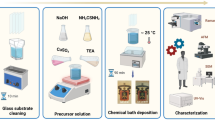Abstract
Carbon quantum dots (CQDs) were prepared by electro-chemical reaction method under reaction conditions such as time and current. The current is 30 mA and time is 3 h. The samples were analyzed using X-ray diffraction, transmission electron microspectroscopy, Fourier transform infrared spectroscopy, photoluminescence spectroscopy, UV–visible spectroscopy, and Hall effect. The results showed that the crystal size calculated by Debye–Scherrer’s formula was 70 nm and a greater peak of 1577 cm−1 obtained from FTIR corresponded to C꞊C, which refers to CQDs. The generated energy surface state was measured, which is 3.17, 2.54, 2.33, and 2.01 eV, and the change in the size of surface state was measured, which is 3.372, 3.089, 2.891, and 2.685 nm, respectively, and the free carrier concentration was 5.008 × 108 cm−2, where it was the nanostructure. It was found by measuring the Hall effect that the CQDs were p-type.







Similar content being viewed by others
Data availability
Data sharing is not applicable to this article as no datasets were created or analyzed during the current study.
References
A. Alagarasi, Chapter- introduction to nanomaterials. Indian Institute of Technology Madras, (2013)
E.S. Bernhardt, B.P. Colman, M.F. Hochella, B.J. Cardinale, R.M. Nisbet, C.J. Richardson, L. Yin, An ecological perspective on nanomaterial impacts in the environment. J. Environ. Qual. 39(6), 1954–1965 (2010)
W.L.F. Armarego, Purification of laboratory chemicals: Part 2 inorganic chemicals, catalysts, biochemicals, physiologically active chemicals, nanomaterials, 9th edn. (Butterworth-Heinemann, Oxford, 2022), pp. 586–630
Y. Wang, A. Hu, Carbon quantum dots: synthesis, properties and applications. J. Mater. Chem. 2(34), 6921–6939 (2014)
S.Y. Lim, W. Shen, Z. Gao, Carbon quantum dots and their applications. Chem. Soc. Rev. 44(1), 362–381 (2015)
R. Wang, K.-Q. Lu, Z.-R. Tang, Y.-J. Xu, Recent progress in carbon quantum dots: synthesis, properties and applications in photocatalysis. J. Mater. Chem. A 5(8), 3717–3734 (2017)
Z. Zhang, T. Zheng, X. Li, J. Xu, H. Zeng, Progress of carbon quantum dots in photocatalysis applications. Part. Part. Syst. Charact. 33(8), 457–472 (2016)
A.H. Abd, Synthesis of carbon quantum dot by electro-chemical method and studying optical, electrical, and structural properties. Chem. Methodol. 6, 825–830 (2022)
J.G. Smith, Organic chemistry, 7th edn. (The McGraw-Hill Companies, New York, 2024)
L.A. Essa, R.K. Jamal, Studying the structural and optical properties of carbon quantum dots prepared by electro-chemical method. J. Opt. (2023). https://doi.org/10.1007/s12596-023-01328-1
J. Coates, Interpretation 13re of infrared spectra, a practical approach, Infrared Spectroscopy, (2006)
J. Song, L. Zhao, Y. Wang, Y. Xue, Y. Deng, X. Zhao, Q. Li, Carbon quantum dots prepared with chitosan for synthesis of CQDs/AuNPs for iodine ions detection. Nanomaterials 8(12), 1043 (2018)
Y.A. Mahmood, B.T. Chiad, Synthesis and spectroscopic study of highly fluorescent carbon dots derived from orange juice with stilbene 420 dye. Iraqi J. Phys. 18(44), 62–68 (2020)
N.L. Hussein, K.S. Khashan, H.M. Rasheed, H.Y. Hammoud, R.M.S. Alhaddad, Simulation of optical energy gap for synthesis carbon quantum dot by laser ablation. Iraqi J. Sci. 5, 52–56 (2019)
I.M. Al-Essa, Fabrication of carbon nanopowder by arc discharge technique. Iraqi J. Phys. 10(19), 41–46 (2012)
A.B.D. Nandiyanto, R. Oktiani, R. Ragadhita, How to read and interpret ftir spectroscope of organic material. Indones. J. Sci. Technol. 4(1), 97–118 (2019)
C. Kittel, Introduction to solid state physics, 8th edn. (Wiley, London, 2005)
P. Surendran, A. Lakshmanan, S.S. Priya, K. Balakrishnan, P. Rameshkumar, K. Kannan, P. Geetha, T.A. Hegde, G. Vinitha, Bioinspired fluorescence carbon quantum dots extracted from natural honey: efficient material for photonic and antibacterial applications. Nano Struct. Nano Objects 24, 100589 (2020)
A.M. Suhail, M.J. Khalifa, N.M. Saeed, O.A. Ibrahim, White light generation from CdS nanoparticles illuminated by UV-LED. Euro. Phys. J. Appl. Phys. 49(3), 30601 (2010)
N.L. Hussein, K.S. Khashan, H.M. Rasheed, H.Y. Hammoud, R.M. ALHaddad, Simulation of optical energy gap for synthesis carbon quantum dot by laser ablation. Iraqi J. Sci. 5, 52–56 (2018)
R.R. Alani, O.A. Ibrahim, Effect of point defects on the structural and optical properties of CdS nanoparticles synthesized by chemical method. Int. J. Mech. Eng. 7(1), 5156–5165 (2022)
M. Sun, X. Ma, X. Chen, Y. Sun, X. Cui, Y. Lin, A nanocomposite of carbon quantum dots and TiO2 nanotube arrays: enhancing photoelectrochemical and photocatalytic properties. RSC Adv. 4(3), 1121–1126 (2014)
L.E. Brus, Electron–electron and electron-hole interactions in small semiconductor crystallites: the size dependence of the lowest excited electronic state. J. Chem. Phys. 80(9), 4403 (1984)
J. Guild, The colorimetric properties of the spectrum. Philoso. Trans. R. Soc. A 230, 681–693 (1931)
P.K. Yadav, S. Chandra, V. Kumar, D. Kumar, S.H. Hasan, Carbon quantum dots: synthesis, structure, properties, and catalytic applications for organic synthesis. Catalysts 13(2), 422 (2023)
P. Kumar, S. Dua, R. Kaur, M. Kumar, G. Bhatt, A review on advancements in carbon quantum dots and their application in photovoltaics. RSC Adv. 12, 4714–4759 (2022)
Funding
The authors have not disclosed any funding.
Author information
Authors and Affiliations
Contributions
Each co-author has made unique contributions to the work. NAA prepared the CQDS and thin films, contributed to writing the article draft, wrote the program for optical properties, and contributed to the analysis of the results. OAI supervised the work and reviewed the article draft.
Corresponding author
Ethics declarations
Conflict of interests
The authors have not disclosed any competing interests.
Ethical approval
The authors would like to declare that they do not have any conflict of interests.
Additional information
Publisher's Note
Springer Nature remains neutral with regard to jurisdictional claims in published maps and institutional affiliations.
Rights and permissions
Springer Nature or its licensor (e.g. a society or other partner) holds exclusive rights to this article under a publishing agreement with the author(s) or other rightsholder(s); author self-archiving of the accepted manuscript version of this article is solely governed by the terms of such publishing agreement and applicable law.
About this article
Cite this article
Abd, N.A., Ibrahim, O.A. Studying the structural, electrical, and optical properties of carbon quantum dot prepared by the electro-chemical method. J Opt (2023). https://doi.org/10.1007/s12596-023-01462-w
Received:
Accepted:
Published:
DOI: https://doi.org/10.1007/s12596-023-01462-w




